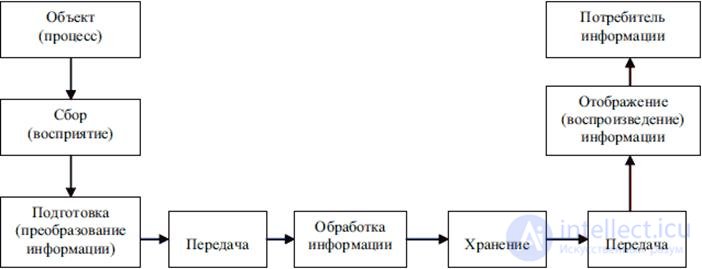Lecture
Information process - the process of obtaining, creating, collecting, processing, accumulating, storing, searching, distributing, using information. [
The information process is a set of sequential actions (operations) performed on information (in the form of data, information, facts, ideas, hypotheses, theories, etc.) to obtain any result (goal achievement).
Information manifests itself in information processes. Information processes always take place in any systems (social, socio-technical, biological, etc.).
The most generalized information processes are the collection, transformation, use of information.

The main information processes studied in the course of informatics include: search, selection, storage, transmission, encoding, processing, protection of information.
Stages of the information process
The movement of information from one subject to another is called the information process. The following stages of the information process are distinguished:
1. Getting information. Reception of information by the subject in a form understandable to him.
2. Storage of information. Systems involved in the storage of information, allow you to use it repeatedly, as well as use a large number of subjects.
3. Transfer of information. Information transfer is carried out using information channels that are responsible for the correct delivery. Before sending, the information is encoded, and before transmission to the subject is decoded.
4. Processing information. Processing information to give it a form that is convenient for the subject.
5. Feedback. Check for distortion of information in the course of the information process.
The effectiveness of the information process, both at the economic level as a whole and at the firm level, determines the quality of their functioning.
Since the material carrier of information is a signal, then in reality these will be the stages of signal inversion and conversion (Fig. 1.6).
At the stage of perception of information, purposeful extraction and analysis of information about an object (process) is carried out, as a result of which an image of an object is formed, its identification and assessment are carried out. The main task at this stage is to separate useful information from disturbing (noise), which in some cases is associated with considerable difficulties.
At the stage of information preparation, its primary transformation is carried out. At this stage, operations such as normalization, analog-to-digital conversion, and encryption are performed. Sometimes the stage of preparation is considered as auxiliary at the stage of perception. As a result of perception and preparation, a signal is obtained in a form suitable for transmission, storage or processing.
At the stage of transmission information is sent from one place to another (from the sender to the recipient - the addressee). Transmission is carried out through channels of different physical nature, the most common of which are electrical, electromagnetic and optical. Extraction of the signal at the output of the channel subjected to the action of noise is shown in Figure 1.6. Basic information processes
nature of secondary perception.
At the stages of information processing, its general and essential interdependencies of interest to the system are revealed. The transformation of information at the stage of processing (as well as at other stages) is carried out either by means of information technology or by man.
Information processing is understood to mean any transformation of it carried out according to the laws of logic, mathematics, as well as informal rules based on “common sense”, intuition, generalized experience, established attitudes and norms of behavior. The result of processing is also information, but either presented in other forms (for example, ordered by some characteristics) or containing answers to the questions posed (for example, solving some problem). If the processing process is formalized, it can be performed by technical means. Fundamental shifts in this area occurred due to the creation of a computer as a universal information transformer, in connection with which the concepts of data and data processing appeared.
The data call the facts, information presented in a formalized form (coded), recorded on these or other media and can be processed with the help of special technical means (primarily computers).
Data processing involves the production of various operations on them, primarily arithmetic and logical, to obtain new data that are objectively necessary (for example, in preparing responsible decisions).
At the storage stage, information is recorded in a storage device for later use. Semiconductor and magnetic carriers are used to store information.
The stage of displaying information should precede the stages associated with human participation. The purpose of this stage is to provide the person with the information he needs with the help of devices capable of affecting his senses.
Comments
To leave a comment
Methods and means of computer information technology
Terms: Methods and means of computer information technology